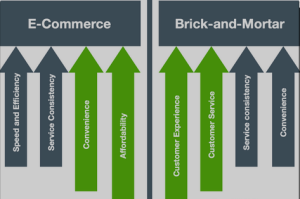The rise of e-commerce has had a profound impact on traditional brick-and-mortar retail, reshaping consumer behavior and challenging the traditional retail landscape. The purpose of this study is to highlight e-commerce’s prospective impact on brick-and-mortar retail:

E-Commerce’s Prospective Impact on Brick-and-Mortar Retail
Table of Contents
ToggleProspective Impact on Brick-and-Mortar Retail:
-
Shift in Consumer Behavior:
- E-commerce has driven a significant shift in consumer behavior, with more people opting for the convenience of online shopping. Traditional retailers may experience reduced foot traffic as a result.
-
Store Closures:
- The growth of e-commerce has led to the closure of some brick-and-mortar stores, particularly among businesses that struggled to adapt to the changing retail environment. This trend may continue, especially for retailers that fail to embrace digital strategies.
-
Rise of Omnichannel Retail:
- Many traditional retailers are adopting omnichannel strategies, integrating online and offline channels to provide a seamless shopping experience. This involves offering online ordering, in-store pickup, and other strategies to blend the strengths of both models.
-
Adoption of Technology in Physical Stores:
- To compete with online retailers, brick-and-mortar stores are increasingly incorporating technology into their operations. This includes implementing mobile payment options, interactive displays, and augmented reality experiences to enhance the in-store shopping experience.
-
Focus on Customer Experience:
- As e-commerce excels in convenience, traditional retailers are placing greater emphasis on providing enhanced customer experiences. This involves creating inviting store layouts, offering personalized services, and organizing events to attract customers.
-
Inventory Management and Efficiency:
- E-commerce allows for more efficient inventory management through data analytics and real-time tracking. Traditional retailers are adopting similar technologies to optimize inventory levels, reduce stockouts, and improve overall operational efficiency.
-
Impact on Shopping Malls:
- The decline of traditional retail has had repercussions for shopping malls, with some facing challenges related to vacant storefronts. However, successful malls are adapting by incorporating entertainment, dining, and experiential offerings to attract visitors.
-
Local and Independent Retailers:
- Some local and independent retailers have found success by leveraging e-commerce platforms to reach a broader audience. The ability to sell online can help smaller businesses compete on a larger scale.
-
Logistical Challenges:
- E-commerce has placed increased demands on logistics and supply chain management. Traditional retailers that enhance their logistics capabilities can better compete with the fast and efficient delivery models of online retailers.
-
Social Commerce Integration:
- The integration of social commerce, where products are sold directly through social media platforms, is impacting both e-commerce and brick-and-mortar retail. Traditional retailers are exploring ways to leverage social media for marketing and sales.
-
Pop-Up Stores and Temporary Retail Spaces:
- To create a sense of urgency and excitement, some retailers are experimenting with pop-up stores and temporary retail spaces. These limited-time events can attract customers who seek unique and exclusive shopping experiences.
-
Sustainability and Local Sourcing:
- Traditional retailers are capitalizing on the growing interest in sustainability and local sourcing. Emphasizing the availability of locally sourced products and eco-friendly practices can be a differentiator.
While e-commerce has posed challenges to brick-and-mortar retail, it’s important to note that both models can coexist and complement each other. Successful retailers often integrate both online and offline strategies to provide a holistic shopping experience that meets the diverse preferences of modern consumers. The future of retail may involve a convergence of digital and physical channels, emphasizing flexibility, convenience, and enhanced customer engagement.
